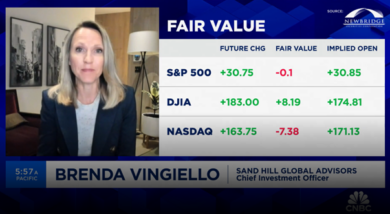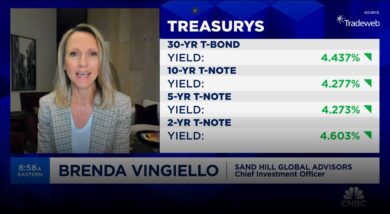Sand Hill's Chief Investment Officer, Brenda Vingiello, CFA, joins Jenny Harrington on “Halftime Report” to go over their most recent portfolio moves. Brenda's commentary begins

Are We There Yet?
Perhaps nothing reminds us more of summer than a family road trip where children, and often adults, become impatient after many hours on the road and begin to wonder, or loudly whine, “Are we there yet?” This summer we have another reason to ask ourselves a version of this classic question. As of the end of June, this economic cycle officially became the longest in U.S. history and many market participants have been asking themselves whether we have finally arrived at the end of the road.
While there have been a few bumps along the way, for the most part the last ten years have been characterized by steady, albeit slow, growth, accompanied by subdued inflation, low unemployment and healthy job growth and, of course, significant asset appreciation. Wishing for an end to the economic cycle is certainly not something we make a habit out of, but being prepared for that eventuality is an important exercise to undertake.
With the exception of Australia, which is currently enjoying its impressive 28th year of an uninterrupted economic growth cycle, developed economies typically experience fairly frequent economic cycles. Since World War II, the U.S. economy has experienced 12 such cycles, including the one we are in today. Historically, these cycles have lasted an average of five years, apart from 1961-1969 and 1991-2001. Statistically speaking, we have only experienced a cycle this long just 2.5% of the time in the last 165 years and only slightly more often than that, or only 4% of the time, since 1945. By all measures, we are currently experiencing what is sometimes called a statistical “tail”. But, in the grand scheme of things, does age really matter?
The answer is yes… and no. We have all heard the common adage that economic expansions do not die of old age. While this is true, it could also be argued that living things don’t really die of old age either. We eventually succumb to symptoms that simply impact us far more severely when we are older than when we are younger; and the same can be true for the economy. When an economy is growing at a strong and steady pace, its ability to weather an unexpected curveball is much higher than when its growth is slowing down.
Usually that curveball takes the form of rising inflationary pressures and a Federal Reserve that tightens interest rates in an attempt to contain rising prices. This time around, with the Federal Reserve easing monetary policy in the late expansion, they are unlikely to be the source of an economic slowdown. Instead, all eyes are on Washington trade negotiations and whether any escalation or prolonged negotiation will create this cycle’s policy mistake that tilts us into an economic contraction. Thus far, this has not been the case, but we continue to watch these developments carefully.
This expansion has been unique in that growth has averaged a mere 2.3%, much lower than the 3.6% that has been typical of the last three expansions.1 This may be due to the severity of the Great Recession, an aging population and regulation that is a direct result of the excesses of the last two economic cycles. Despite its slow-growth nature, though, economic conditions have still been pretty good. Inflation continues to be contained, interest rates remain low, and the job market shows ongoing strength; and, as a result, consumers’ balance sheets are collectively in great shape.
Indeed, with so many parts of the economy still doing so well at this stage, would it be possible for the U.S. to follow in Australia’s footsteps? The answer is probably not. Australia has some unique attributes that have contributed to its growth. The country essentially avoided the disastrous subprime lending boom since banks were, and continue to be, primarily focused on domestic “bread-and-butter” banking. Their immigrant situation is unique as, according to the Australian Bureau of Statistics, an astounding quarter of the current population have been born abroad. People tend to immigrate when they are younger and this has contributed to significant growth of the country’s working age population. Australia is also well-positioned geographically to take advantage of its close proximity to many of the more rapidly developing countries in the world. In addition, Australia has benefited from the significant demand for its many natural resources and commodities caused by China’s substantial fiscal stimulus efforts following the 2008/2009 recession, and it continues to have an engaged and open trade agreement with that country.
Switching back to the U.S. and the potential for the continuation of its existing economic cycle, it needs to be recognized that much has changed since the beginning of the year as global growth has generally begun to wane, while trade tensions have picked up meaningfully between the U.S. and the second largest global economy, China, and also with Mexico and Europe, too. Manufacturing, housing and business confidence have all weakened as a result. The Federal Reserve has responded by signaling plans to lower interest rates in order to support continued economic growth.
One of the biggest questions facing economists and financial market participants is whether the Federal Reserve’s actions can offset these pressures. After all, we are in a late stage of the cycle when the economy may have more difficulty overcoming obstacles than it did just a few years ago. Furthermore, with interest rates already at historically low levels, the Federal Reserve will be dipping into its limited tool chest, leaving fewer options for future periods. The other big related question is what continues to happen on the trade front, and tensions may persist since limited progress appears to have been made between the U.S. and China over the past six months or so.
Despite the headline worries, the stock market has appreciated throughout the year to new all-time highs as hope for continued economic growth, aided by stimulus from the Federal Reserve, has grown. Meanwhile, the yield curve has become incredibly flat. Along the way, our approach has been to opportunistically reduce exposure to growth assets. At this point, we still don’t see a natural end to this cycle, and thus we are not “there yet”; but we do feel that we are getting closer to the end and we have chosen to take an increasingly moderate approach on your behalf. We continue to monitor the global economy to determine whether the recent stepped-up central bank efforts are having their desired outcomes. Additionally, we recognize that further clarity on global trade would positively impact the overall economic outlook and corporate earnings. Nevertheless, the stock market has appreciated very nicely this year, despite coming off a very difficult December, and all things considered, we are being a little more cautious as this decade long “road trip” enters the summer of 2019.
1 ”America’s Expansion is now the Longest on Record.” The Economist. 11 July 2019
Articles and Commentary
Information provided in written articles are for informational purposes only and should not be considered investment advice. There is a risk of loss from investments in securities, including the risk of loss of principal. The information contained herein reflects Sand Hill Global Advisors' (“SHGA”) views as of the date of publication. Such views are subject to change at any time without notice due to changes in market or economic conditions and may not necessarily come to pass. SHGA does not provide tax or legal advice. To the extent that any material herein concerns tax or legal matters, such information is not intended to be solely relied upon nor used for the purpose of making tax and/or legal decisions without first seeking independent advice from a tax and/or legal professional. SHGA has obtained the information provided herein from various third party sources believed to be reliable but such information is not guaranteed. Certain links in this site connect to other websites maintained by third parties over whom SHGA has no control. SHGA makes no representations as to the accuracy or any other aspect of information contained in other Web Sites. Any forward looking statements or forecasts are based on assumptions and actual results are expected to vary from any such statements or forecasts. No reliance should be placed on any such statements or forecasts when making any investment decision. SHGA is not responsible for the consequences of any decisions or actions taken as a result of information provided in this presentation and does not warrant or guarantee the accuracy or completeness of this information. No part of this material may be (i) copied, photocopied, or duplicated in any form, by any means, or (ii) redistributed without the prior written consent of SHGA.
Video Presentations
All video presentations discuss certain investment products and/or securities and are being provided for informational purposes only, and should not be considered, and is not, investment, financial planning, tax or legal advice; nor is it a recommendation to buy or sell any securities. Investing in securities involves varying degrees of risk, and there can be no assurance that any specific investment will be profitable or suitable for a particular client’s financial situation or risk tolerance. Past performance is not a guarantee of future returns. Individual performance results will vary. The opinions expressed in the video reflect Sand Hill Global Advisor’s (“SHGA”) or Brenda Vingiello’s (as applicable) views as of the date of the video. Such views are subject to change at any point without notice. Any comments, opinions, or recommendations made by any host or other guest not affiliated with SHGA in this video do not necessarily reflect the views of SHGA, and non-SHGA persons appearing in this video do not fall under the supervisory purview of SHGA. You should not treat any opinion expressed by SHGA or Ms. Vingiello as a specific inducement to make a particular investment or follow a particular strategy, but only as an expression of general opinion. Nothing presented herein is or is intended to constitute investment advice, and no investment decision should be made based solely on any information provided on this video. There is a risk of loss from an investment in securities, including the risk of loss of principal. Neither SHGA nor Ms. Vingiello guarantees any specific outcome or profit. Any forward-looking statements or forecasts contained in the video are based on assumptions and actual results may vary from any such statements or forecasts. SHGA or one of its employees may have a position in the securities discussed and may purchase or sell such securities from time to time. Some of the information in this video has been obtained from third party sources. While SHGA believes such third-party information is reliable, SHGA does not guarantee its accuracy, timeliness or completeness. SHGA encourages you to consult with a professional financial advisor prior to making any investment decision.
Other Posts By This Author
- – CNBC Halftime: Portfolio Moves | March 14, 2024
- – CNBC Squawk Box: Market Trends | March 6, 2024
- – CNBC Squawk Box: CPI Report | February 13, 2024
- – Getting Back to Normal
Related Posts







